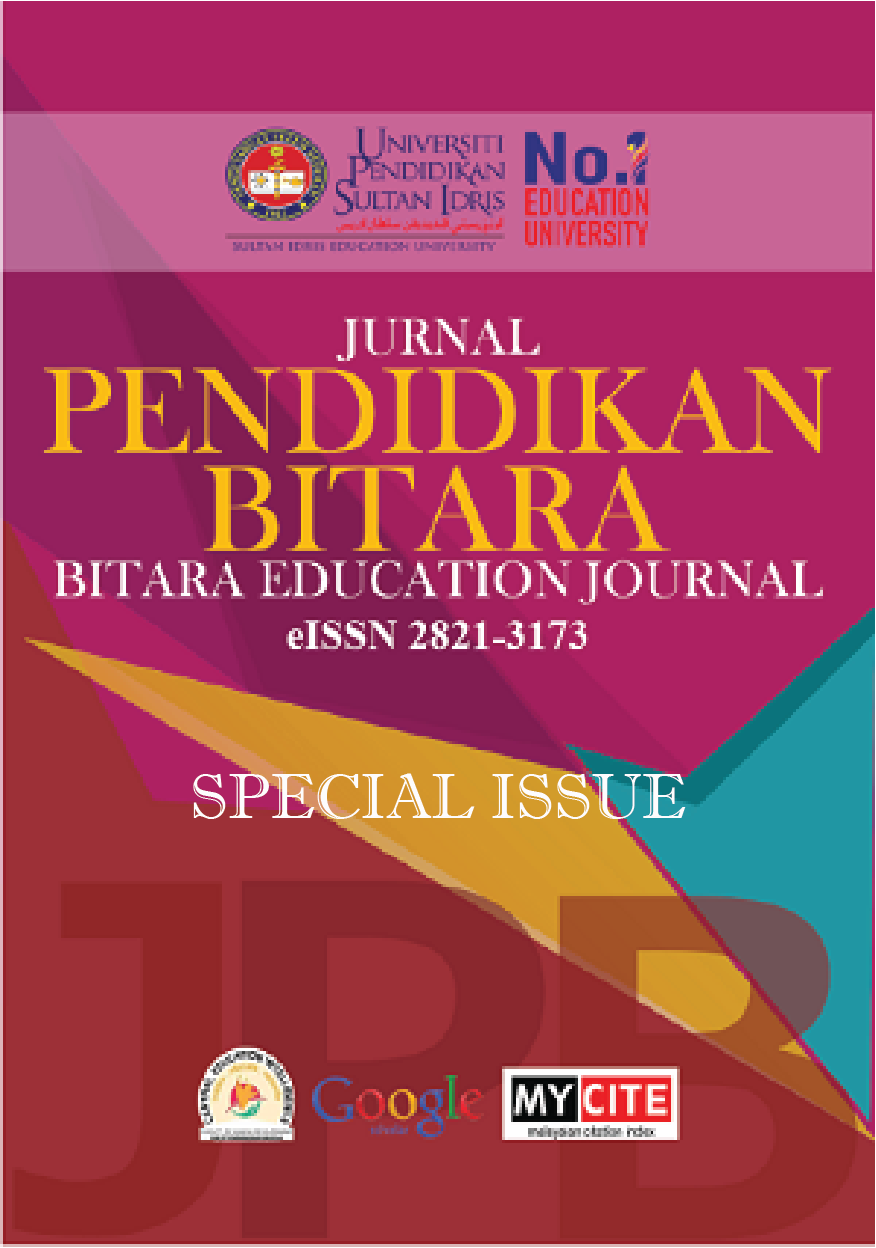Construction of Pictorial Dictionary for the Concept of Shape and Size in Early Mathematics Education of 4 Years Old Children
Pembinaan Kamus Bergambar bagi Konsep Bentuk dan Saiz dalam Pendidikan Matematik Awal Kanak-Kanak 4 Tahun
DOI:
https://doi.org/10.37134/bitara.vol15.sp.20.2022Keywords:
Pictorial Dictionary, Concept of Shape and Size, Early Mathematics Education, Nursery LearningAbstract
This study aims to look at the needs and effectiveness of the use of photography dictionaries for the concept of shape and size in Mathematics Education towards children's learning in nursery. The objective of this study is to analyze the requirements of learning the concept of shape and size, designing and developing a dictionary of Early Mathematics Education for the concept of shape and size and also evaluating the usability of a photo dictionary for the concept of shape and size in Early Mathematics Education. This study was conducted using the design and development research (DDR) method in building a photo dictionary for the learning of shape and size concepts. The study sample for phase one was 100 respondents comprising parents, nursery teachers and Early Childhood Education (ECE) students for questionnaires while in phase two and three were nursery teachers and an expert in Science, Technology, Engineering and Mathematics (STEM) fields to be interviewed. The findings from this study found that the use of photo dictionaries for the concept of shape and size is still relevant for use by educators and carers in providing learning as a teaching aid to children. The photo dictionary produced should be in accordance with the age of the child and be able to give them a good understanding. The use of this photo dictionary should also be guided by educators or guardians so as not to occur confusion between children. Therefore, teachers and parents play a high role using teaching aid which is effective and meaningful in children's learning so that they acquire the knowledge without any willingness or confusion.
Downloads
References
Abdul Halim, Lilia Halim, T. Subahan Mohd Meerah & Kamisah Osman. (2010). Pembangunan instrumen penyelesaian masalah sains. Jurnal Pendidikan Malaysia, 35(1), 35-39.
Abdul Halim Masnan & Nor Mahitah Mohd Radzi. (2015). Pengetahuan persediaan pengajaran guru prasekolah baru. Jurnal Pendidikan Awal Kanak-Kanak Kebangsaan, 4, 90-108.
Angela Anthonysamy (1995). Perkembangan pemikiran matematik pada peringkat awal kanak-kanak: Satu pendekatan konstruktivisme. Universiti Malaysia Sarawak.
Björklund, C., van den Heuvel-Panhuizen, M., & Kullberg, A. (2020). Research on early childhood mathematics teaching and learning. ZDM, 1-13.
Connie Shin & Juppri Bacotang. (2019). Kesan kaedah mengajar terhadap pencapaian awal matematik dalam kalangan kanak-kanak prasekolah. Jurnal Pendidikan Awal Kanakkanak Kebangsaan, 8, 8-16.
Low, H. M., Lee, L. W., Che Ahamd, A., The, S. Y., & A. Khadar, N. Z. (2021). Preparing Malaysian Pre-Service Teachers to Teach Students with Autism Using E-Module ‘The Story of Khamdy’. Jurnal Pendidikan Bitara UPSI, 14, 47-56.
McClure, E. R., Guernsey, L., Clements, D. H., Bales, S. N., Nichols, J., Kendall-Taylor, N., & Levine, M. H. (2017). STEM starts early: Grounding science, technology, engineering, and math education in early childhood. New York: NY: The Joan Ganz Cooney Center at Sesame Workshop.
Nik Salmi Nurulhuda Mohd Sainain, Romarzila Omar, Hazhari Ismail, Nordin Mamat & Ruslan Abdullah. (2020). Parental Knowledge And Development Of Languages And Literacy, Communication And Socializations In The Early Childhood Education. Master of Education in Sultan Idris Education University
Noviyanti, M. (2019). Teachers’ belief in mathematics teaching: a case study of early childhood education teachers. Journal of Physics: Conference Series, 1315(1).
Nurdiyana Tasripin & Kamariah Abu Bakar. (2018). Permainan interaktif dalam pembelajaran pranombor dan pendidikan matematik prasekolah. Seminar Antarabangsa Isu-Isu Pendidikan (ISPEN2018).
Rittle-Johnson, B., Zippert, E. L., & Boice, K. L. (2019). The roles of patterning and spatial skills in early mathematics development. Early Childhood Research Quarterly, 46, 166-178.
Sobey, N. (2019). Does working in collaborative groups to complete STEM design challenges increase student engagement among prescholl-aged children? Doctoral dissertation, Hofstra University.
Walijah Ahmad Jamburi. (2010). Penghayatan ibadah dalam kalangan pelajar Islam: Kajian di beberapa buah sekolah menengah kebangsaan di Petaling Jaya, Selangor. Master of University Malaya.
Worthington, M., Dobber, M., & van Oers, B. (2019). The development of mathematical abstraction in the nursery. Educational Studies in Mathematics, 102(1), 91-110.
Zakiah Mohamad Ashari. (2014). Aplikasi modul belajar melalui bermain dalam kefahaman awal matematik dan motivasi kanak-kanak prasekolah. Universiti Teknologi Malaysia.





